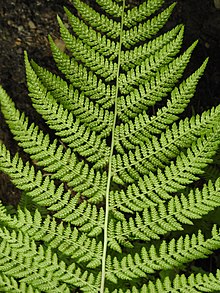
Back Vaatplant Afrikaans Gefäßpflanzen ALS نباتات وعائية Arabic نباتات وعائيه ARZ Tracheophyta AST Borulu bitkilər Azerbaijani Сасудзістыя расліны Byelorussian Судзінкавыя расьліны BE-X-OLD Васкуларни растения Bulgarian সংবাহী উদ্ভিদ Bengali/Bangla
| Vascular plant Temporal range:
| |
|---|---|

| |
| Common lady-fern, a non-seed-bearing plant | |

| |
| Lemon basil, a seed-bearing plant | |
| Scientific classification | |
| Kingdom: | Plantae |
| Clade: | Embryophytes |
| Clade: | Polysporangiophytes |
| Clade: | Tracheophytes Sinnott, 1935[3] ex Cavalier-Smith, 1998[4] |
| Divisions † Extinct | |
| |
Vascular plants (from Latin vasculum 'duct'), also called tracheophytes (UK: /ˈtrækiːəˌfaɪts/,[5] US: /ˈtreɪkiːəˌfaɪts/)[6] or collectively tracheophyta (/ˌtreɪkiːˈɒfɪtə/;[7][8][9] from Ancient Greek τραχεῖα ἀρτηρία (trakheîa artēría) 'windpipe' and φυτά (phutá) 'plants'),[9] are plants that have lignified tissues (the xylem) for conducting water and minerals throughout the plant. They also have a specialized non-lignified tissue (the phloem) to conduct products of photosynthesis. The group includes most land plants (c. 300,000 accepted known species)[10] other than mosses.
Vascular plants include the clubmosses, horsetails, ferns, gymnosperms (including conifers), and angiosperms (flowering plants). They are contrasted with nonvascular plants such as mosses and green algae. Scientific names for the vascular plants group include Tracheophyta,[11][4]: 251 Tracheobionta[12] and Equisetopsida sensu lato. Some early land plants (the rhyniophytes) had less developed vascular tissue; the term eutracheophyte has been used for all other vascular plants, including all living ones.
Historically, vascular plants were known as "higher plants", as it was believed that they were further evolved than other plants due to being more complex organisms. However, this is an antiquated remnant of the obsolete scala naturae, and the term is generally considered to be unscientific.[13]
- ^ D. Edwards; Feehan, J. (1980). "Records of Cooksonia-type sporangia from late Wenlock strata in Ireland". Nature. 287 (5777): 41–42. Bibcode:1980Natur.287...41E. doi:10.1038/287041a0.
- ^ Laura Wegener Parfrey; Daniel J G Lahr; Andrew H Knoll; Laura A Katz (16 August 2011). "Estimating the timing of early eukaryotic diversification with multigene molecular clocks" (PDF). Proceedings of the National Academy of Sciences of the United States of America. 108 (33): 13624–9. Bibcode:2011PNAS..10813624P. doi:10.1073/PNAS.1110633108. ISSN 0027-8424. PMC 3158185. PMID 21810989. Wikidata Q24614721.
- ^ Sinnott, E. W. 1935. Botany. Principles and Problems, 3d edition. McGraw-Hill, New York.
- ^ a b Cavalier-Smith, T. (August 1998). "A revised six-kingdom system of life". Biological Reviews. 73 (3): 203–266. doi:10.1111/j.1469-185X.1998.tb00030.x. PMID 9809012.
- ^ "tracheophyte". Oxford English Dictionary (Online ed.). Oxford University Press. (Subscription or participating institution membership required.)
- ^ "tracheophyte". Merriam-Webster.com Dictionary. Merriam-Webster.
- ^ "Tracheophyta". Merriam-Webster.com Dictionary. Merriam-Webster.
- ^ "vascular plant | Definition, Characteristics, Taxonomy, Examples, & Facts". Britannica. Retrieved 2022-03-22.
- ^ a b Simpson, Michael G. (2010). "Evolution and Diversity of Vascular Plants". Plant Systematics. pp. 73–128. doi:10.1016/B978-0-12-374380-0.50004-X. ISBN 978-0-12-374380-0.
- ^ Christenhusz, M. J. M.; Byng, J. W. (2016). "The number of known plants species in the world and its annual increase". Phytotaxa. 261 (3): 201–217. doi:10.11646/phytotaxa.261.3.1.
- ^ Abercrombie, Michael; Hickman, C. J.; Johnson, M. L. (1966). A Dictionary of Biology. Penguin Books.
- ^ "ITIS Standard Report Page: Tracheobionta". Retrieved September 20, 2013.
- ^ "Vascular Plants: Definition, Classification, Characteristics & Examples". Sciencing. Retrieved 2022-03-22.